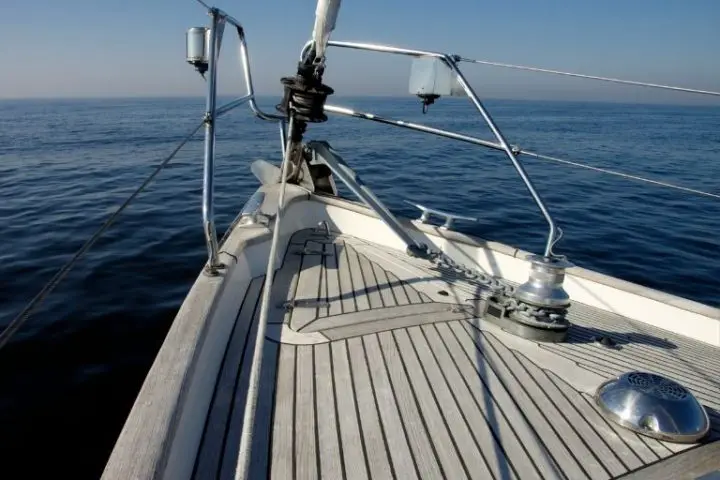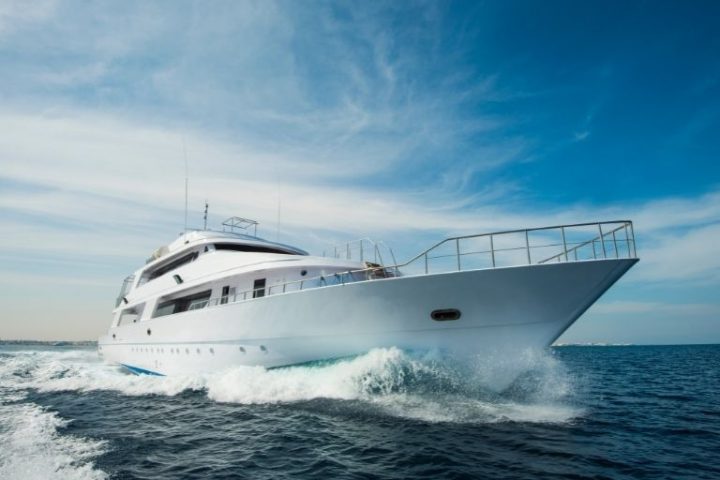Hey! This site is reader-supported and we earn commissions if you purchase products from retailers after clicking on a link from our site.
Each coast of North America has its dream destination. Those that live in New England are a few days’ passage away from Bermuda. The Bahamas are even closer to the Carolinas and Florida. And some thirsty Gulf sailor’s dream of sipping margaritas in Mexico.
But on the west coast, Hawaii is the jewel that hangs just beyond the horizon. So, for those lucky Californians, how long would it take to sail there, and what type of trip would it be? Here’s a closer look at one of the world’s most epic sailing passages.
Table of Contents
Perspective on the Passage
Before we look at the specifics of planning the trip, let’s look at some raw numbers.
How many nautical miles is it from San Francisco to Hawaii? The answer might surprise you—it’s a whopping 2,084 nautical miles.
In land terms, that’s roughly the same distance as LA to Washington, DC. But we aren’t talking about hopping in your SUV and driving across the country at 70 mph. That’s a big enough adventure for most people.
Sailing to Hawaii means inching towards those leis and mai-tais at a steady—but snail-like—six to eight knots. That’s the average speed of most cruising vessels. At those speeds, the trip will take you somewhere between 14 and 18 days.
Operating any vessel for 18 days or more out of the sight of land requires an insane amount of preparation and experience. To be prepared for a safe passage, you’ll want to take your time to get your boat and crew ready for the experience. The following six steps might make it sound quick and easy, but truth be told, it can take years to get ready for a trip like this.

Step 1 – Find a Bluewater Boat and Outfit It
The first step of the journey to Hawaii is to find the right boat for the job. It is a serious bluewater passage between the two states. Unfortunately, most sailboats are not built for it and aren’t up to the task. And most of the sturdy bluewater boats out there which are built for it will still need repairs, upgrades, and outfitting for the voyage.
You can look at our recent article Best Bluewater Cruising Sailboats to give you an idea of the types of craft that are suited for the trip. In short, it needs to be well-built and outfitted with tons of offshore safety gear.
Most boats making this trip will be 40 feet long or longer. Smaller boats can and do make the journey, but usually with solo sailors. A 40-foot cruising vessel has a good balance of affordability, capacity, and performance. It will carry enough stores and supplies, including water, for such a long trip. And it will easily make the aforementioned six-knot speed along the way. A shorter boat will move slower.
Step 2 – Gain Some Offshore Sailing Experience First
If you’re a new sailor, hopping in a boat and heading west right away isn’t the best plan. A better bet is to build up some experience making coastal hops.
Spend some time cruising Mexico and the Sea of Cortez. As you’ll see in step five below, this is on the way to Hawaii anyway. But more importantly, it will give you some practice cruising the boat long distances and living aboard. And it’s far enough of a trip that you can work your way up to longer and longer passages. By starting with overnight hops and working up to multi-day passages, you’ll get a feel for what it’s like to cross oceans in no time.
Step 3 – Provision for the Passage
Having the boat and experience are the first steps, and the next step is simply getting ready to make the actual passage. That means your vessel will be serviced and in tip-top shape, needing no work with everything functioning perfectly. You’ll also want to have a good supply of spare parts aboard, so that should anything break during passage, you’ll be able to repair it at sea.
Once the boat is settled, you’ll need to turn your attention to your crew. You must carry enough water on board for the entire trip, plus extra in reserve. You’ll want to be completely topped off with fuel, and you should have enough food for everyone to live normally and comfortably for one and a half times the length of the anticipated passage.
That means buying all groceries and supplies that you’ll need to live for an entire month and then fitting them into your small boat. Think of everything because there are no 7/11s or Quick Stops out there!
Step 4 – Depart at the Right Time of Year
As you’ll see in step five, picking the winds for your departure is related to the location and presence of the Pacific High weather system. You’ll want to make the trip at a time of year when that high pressure area is well established and predictable—which means most likely in the late spring or early summer.
But other factors must be considered, too. Summer and fall are the eastern Pacific’s hurricane season. These storms ply the very same waters that you’ll want to use, and they track along in the same prevailing winds that you’re seeking out. Officially, hurricane season is from May 15 to November 30, but of course, it is technically possible to experience storms outside of those dates.
Step 5 – Plot Your Course Carefully
Any offshore passage is a balance between the prevailing winds, the long-range weather forecasts, and the ocean currents. The sailor does not simply point their vessel where they want to go—they must plan their route based on which way the winds are blowing.
The prominent weather feature in the North Pacific Ocean is the Pacific High, which is typically located directly between Hawaii and California. Sailing directly into an area of high pressure carries a high likelihood of becoming becalmed. The sinking and still air in the middle will leave your sails limp and your boat adrift.
This might spell great weather for a motor vessel, so long as they have enough fuel to get there. But since most sailboats carry very little fuel—much less 2,000 miles worth. So they’ll have to use the Pacific High to their advantage.
Winds flow clockwise around high pressure systems in the northern hemisphere, and a sailor can plan their route based on this. If a strong high pressure system is active, you should have tailwinds if you follow the California coast southbound. As the winds turn around the periphery of the high, you can then turn your vessel west towards Hawaii, riding favorable winds aft of the beam the entire way.
This band of consistent east winds north of the equator is known as the northeast trade winds. Sailors have been following them around the world for centuries. They blow out of the northeast to east and push vessels westbound.
The high pressure area moves around and goes through strong and weak phases. All of this means significant changes to the exact location of the trade winds, so before departure, the prudent sailor would watch the long-range computer forecast models very carefully.
The journey south before turning west adds a few hundred miles to your journey. But it provides consistent and well-forecasted winds and ensures you won’t be becalmed at sea.
So, how long does it take to sail from California to Hawaii? Most cruising vessels make six knots at sea. So, using conservative numbers, the total distance traveled will be around 2,700 nautical miles. That means the journey should take about 450 hours, or 18 days and 18 hours.
Some performance boats can cut this time in half, but this conservative number is probably the most accurate for most sailboats. Ideally, even a slow boat would hope to have better winds and make more than six knots—but it generally doesn’t work out that way.
The Transpacific Yacht Club holds an annual race from Los Angeles to Honolulu. The current record was set in 2017 by the sailing yacht Comanche, which finished the route in just over five days! That yacht, however, is a 100-foot-long Supermaxi racing yacht. It is certainly not typical of any other class of ocean cruiser. Its average speed is regularly over 20 knots, and it is known to be one of the world’s fastest sailing monohulls.
Step 6 – Getting Home
If all of that sounds like a challenge, wait until you get there and are ready to come home! Yachts headed from Hawaii back to California face the same obstacles, but they cannot retrace their steps because then they would have headwinds the entire way.
That means that the only way home is to follow the wind patterns and head north from the islands. Ideally, you’ll track along the west and north sides of the high pressure zone until you are in the westerly trade winds. These will then take you to the Pacific Northwest for landfall in British Columbia or Washington state. From there, you can follow the coast southbound to your home port.

Final Thoughts
Jimmy Cornell’s World Cruising Routes is one of the best references for planning long voyages and ocean passages. The book covers the hows and the whys of these routings. It also describes the challenges associated with each of them. The route to Hawaii from California is described, as are the routes from Hawaii to the Pacific Northwest.
Voyaging to far-away destinations is something that many people dream of, but few actually do. It takes years of planning and preparation to make such a trip happen, plus a rare level of dedication to see it through. It’s certainly nothing like hopping in your car and driving across the country.
Sailing across oceans means you must exercise complete self-sufficiency, no matter what. Rescue services may be days away if they can reach you at all. As the most fundamental risk mitigation technique, your boat must be in tip-top shape and your sailing skills expert-level.
Imagine being out of cell phone range and more-or-less completely disconnected for 20 days or more. For the entire time, your only contact with other humans will be within the confines of your small boat. Every problem that pops up, you and your crew must address it alone. You have to be ready for equipment failures, injuries, or terrible weather. Having the right boat and a good plan goes a long way toward making the passage fun and comfortable.
Every year, serious sailors make this journey safely. They are rewarded with a Hawaiian welcome and an adventure story that will thrill the grandkids. If you dream of pointing your bow towards the exotic islands of the Pacific, start planning your adventure. While the journey of 1,000 miles begins with a single step, the journey of 2,084 nautical miles begins with a step-by-step well thought out plan.

The passage to Hawaii is one of the longest and most storied bluewater passages on Earth. Plus, its connection to those lovely tropical islands fills it with romanticism and adventure. Aloha!





